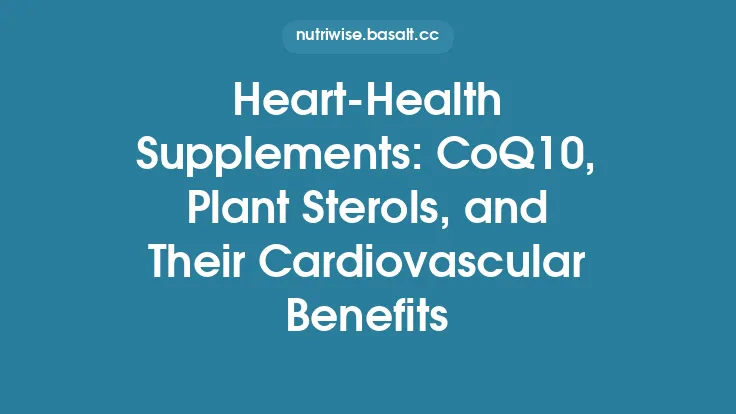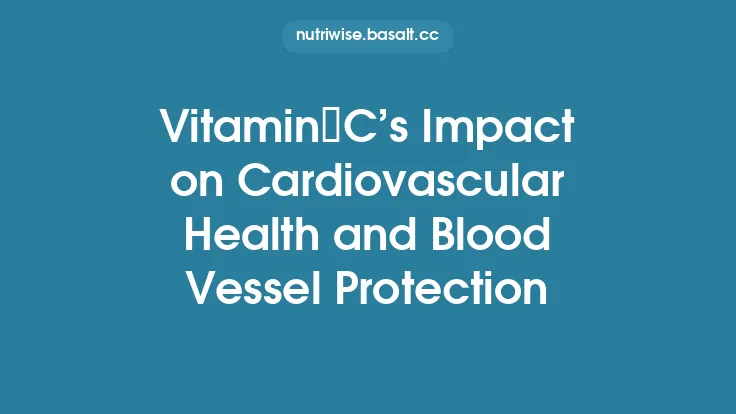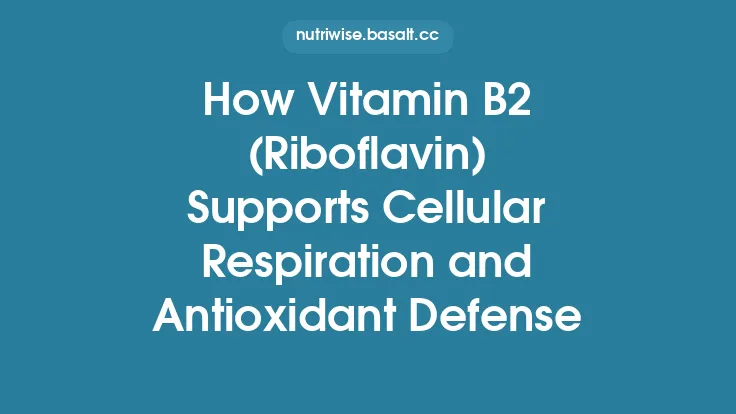Vitamin‚ÄØC (ascorbic acid) is one of the most versatile micronutrients in human biology. Beyond its well‚Äëknown role as a dietary vitamin, it functions as a potent, water‚Äësoluble antioxidant that participates in a wide array of cellular processes. Its ability to donate electrons, chelate transition metals, and recycle other antioxidant molecules makes it a central player in maintaining redox homeostasis. Understanding how vitamin‚ÄØC exerts these effects provides insight into its broader contributions to health and disease prevention.
Molecular Basis of Vitamin C’s Antioxidant Capacity
Vitamin C’s antioxidant power stems from its unique chemical structure: a six‑carbon lactone ring bearing two enediol hydroxyl groups. In physiological pH, the molecule exists primarily as the ascorbate anion, which readily donates a single electron to reactive species, becoming the relatively stable ascorbyl radical. This radical can be reduced back to ascorbate by cellular reductants, allowing the antioxidant cycle to continue without generating additional reactive intermediates.
Key features that underlie its effectiveness include:
- Low redox potential – The standard reduction potential of the ascorbate/dehydroascorbate couple (~+0.06 V) is sufficiently low to reduce many biologically relevant oxidants, yet high enough to avoid indiscriminate reduction of essential signaling molecules.
- Rapid reaction kinetics – Ascorbate reacts with superoxide, peroxyl radicals, and singlet oxygen at diffusion‑controlled rates, outcompeting many other cellular constituents.
- Metal‑chelating ability – The enediol moiety can bind Fe²⁺ and Cu⁺, limiting their participation in Fenton‑type reactions that generate highly damaging hydroxyl radicals.
These properties enable vitamin‚ÄØC to act as a first‚Äëline defense against a spectrum of oxidative challenges that arise from normal metabolism, environmental exposures, and physiological stressors.
Protection of Cellular Macromolecules
Reactive oxygen and nitrogen species (ROS/RNS) can modify nucleic acids, lipids, and proteins, leading to functional impairment and cellular dysfunction. Vitamin‚ÄØC contributes to the preservation of each macromolecular class:
- DNA and RNA – Ascorbate scavenges hydroxyl radicals that would otherwise induce strand breaks, base modifications (e.g., 8‑oxoguanine), and cross‑linking. By limiting oxidative lesions, vitamin C helps maintain genomic stability and supports accurate transcription and replication.
- Lipids – Lipid peroxidation propagates membrane damage and generates secondary electrophiles. Ascorbate intercepts peroxyl radicals, terminating chain reactions and preserving membrane fluidity. This protection extends to phospholipids, cholesterol esters, and polyunsaturated fatty acids that are essential for cellular signaling.
- Proteins – Oxidative modifications such as carbonyl formation, disulfide bond reshuffling, and methionine sulfoxide can alter enzyme activity and structural integrity. Vitamin C reduces protein‑bound radicals and prevents irreversible oxidation of critical thiol groups, thereby sustaining enzymatic function and protein turnover.
Integration with Enzymatic Antioxidant Systems
While vitamin C acts directly as a radical scavenger, it also interfaces with the body’s enzymatic antioxidant network:
- Regeneration of other antioxidants – Ascorbate can reduce oxidized forms of glutathione, α‑tocopherol (vitamin E), and ubiquinol, restoring their antioxidant capacity. This recycling amplifies the overall cellular antioxidant pool without requiring additional nutrient intake.
- Cofactor for antioxidant enzymes – Certain enzymes, such as prolyl and lysyl hydroxylases involved in collagen maturation, require ascorbate for optimal activity. Although collagen synthesis is a distinct topic, the underlying principle illustrates how vitamin C’s redox properties enable enzymatic reactions that indirectly support antioxidant defenses.
- Modulation of NADPH‑dependent pathways – By influencing the redox state of the cytosol, ascorbate can affect the activity of NADPH‑oxidases and other NADPH‑utilizing enzymes, thereby fine‑tuning the balance between ROS production and detoxification.
Impact on Cellular Signaling and Gene Regulation
Redox balance is a critical regulator of intracellular signaling cascades. Vitamin C’s ability to modulate the oxidative environment translates into effects on gene expression and signal transduction:
- Transcription factor modulation – Redox‑sensitive transcription factors such as NF‑κB, AP‑1, and Nrf2 respond to changes in intracellular ROS levels. By maintaining a reduced milieu, vitamin C can attenuate the activation of pro‑inflammatory pathways (e.g., NF‑κB) and promote the expression of phase‑II detoxifying enzymes via Nrf2 activation.
- Epigenetic influence – Ascorbate serves as a cofactor for Fe²⁺/2‑oxoglutarate‑dependent dioxygenases, including the TET family of DNA demethylases and Jumonji‑C domain histone demethylases. These enzymes require a reduced iron center, which ascorbate helps maintain, thereby facilitating active DNA and histone demethylation. This epigenetic regulation can affect cellular differentiation, stress responses, and metabolic programming.
- Mitochondrial function – Within the mitochondrial matrix, vitamin C helps preserve the redox state of the electron transport chain components, supporting efficient ATP production and limiting electron leak that would otherwise generate superoxide.
Health Implications of Vitamin C’s Antioxidant Activity
The cumulative effect of vitamin C’s antioxidant actions manifests in several broad health outcomes:
- Age‑related cellular decline – By protecting DNA, lipids, and proteins from cumulative oxidative damage, vitamin C contributes to the preservation of cellular function over the lifespan, potentially slowing aspects of biological aging.
- Neuroprotection – Neurons are highly susceptible to oxidative injury due to their high metabolic rate and abundant polyunsaturated fatty acids. Vitamin C’s capacity to scavenge ROS, chelate transition metals, and support redox‑sensitive signaling pathways helps maintain neuronal integrity and may mitigate the progression of neurodegenerative processes.
- Metabolic health – Oxidative stress is implicated in insulin resistance and dysregulated glucose metabolism. By sustaining redox homeostasis, vitamin C can influence insulin signaling pathways and improve cellular glucose handling, supporting metabolic equilibrium.
- Detoxification and xenobiotic clearance – The liver’s phase‑I and phase‑II detoxification enzymes operate optimally in a reduced environment. Vitamin C’s role in maintaining this environment enhances the liver’s ability to metabolize and eliminate environmental toxins and endogenous waste products.
These benefits are not confined to a single organ system; rather, they reflect the systemic nature of redox regulation and the widespread distribution of vitamin‚ÄØC in aqueous compartments of the body.
Maintaining Adequate Antioxidant Status
Because vitamin‚ÄØC is water‚Äësoluble and not stored in large reserves, the body relies on a continuous supply to sustain its antioxidant functions. Strategies to preserve optimal intracellular ascorbate levels include:
- Balanced dietary intake – Consuming a variety of fruits and vegetables that naturally contain vitamin C ensures a steady influx of the nutrient. While specific food lists are beyond the scope of this article, the principle of dietary diversity remains central.
- Minimizing oxidative burdens – Reducing exposure to environmental pollutants, tobacco smoke, and excessive ultraviolet radiation can lower the demand for antioxidant defenses, allowing existing vitamin C stores to be allocated more efficiently.
- Supporting synergistic nutrients – Although the interaction with other antioxidants is a distinct topic, it is worth noting that a well‑rounded micronutrient profile (including minerals such as zinc and selenium) supports the enzymatic systems that work in concert with vitamin C.
By integrating these practices into daily life, individuals can help ensure that vitamin‚ÄØC remains available to perform its essential antioxidant duties, thereby contributing to overall physiological resilience.





